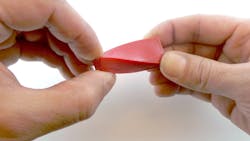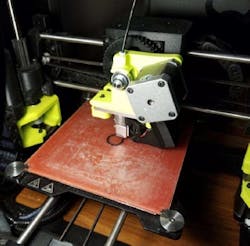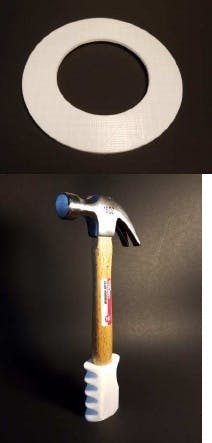Michigan University’s Dr. Joshua Pearce does a lot of work on 3D printing. Recently, he published a 20-page report, "Distributed Manufacturing of Flexible Products: Technical Feasibility and Economic Viability,” showing the return on investment (ROI) of 3D printing at home. In the report, he walks through 20 common flexible household products, postulating that by simply 3D printing these products rather than buying them, a 3D printer could pay for itself.
Flexible products add a bit of a challenge. When considering a ROI on your printer, the filament can cost three times that of normal filament. Also, there might be modifications to the extruder, or the need for a completely new extruder to obtain better prints. This all adds to the cost of the parts making a ROI difficult. Despite this, the report suggests there is still a beneficial ROI to 3D printing flexible parts.
The main factors that were considered was the cost of the materials consumed (NinjaFlex), and the cost of the electricity consumed running a Lulzbot Mini. The use of flexible filaments requires special hardware to obtain successful 3D prints. The report added that extruders for flexible filament demand a direct path to the hot end, with no open areas where the filament can kink.
Several extruder options are available for flexible filament. The simplest option being to use a polytetrafluoroethylene (PTFE) tube that is the exact size of the filament (either 1.75 mm or 2.85 mm for the two most common filament diameters) to create a direct path from the drive gear to the hot end. This is the least expensive option, but also requires non-trivial technical knowledge.
Other solutions include:
- Flexion Extruder ($99)
- It fits on most fused filament fabricators (FFF)-class 3-D printers and is made for only flexible materials.
- FlexyStruder ($295)
- This works on the open-source Lulzbot line of 3D printers.
For this analysis, it was critical that the methods of manufacturing and materials were relevant and accessible to the average consumer.
1. The Lulzbot Mini with FlexyStruder reduced the number of failed prints that can increase when working with higher-end materials—especially materials that can flex.
Results
In general an average savings of 75% was found when compared to the least expensive commercially equivalent products, and 92% when compared to higher market-priced products. With this savings a user would have to print roughly 160 flexible objects to recover the capital costs.
The Breakdown
6 – Parts for automotive, including belts and gaskets
2 – Parts for medical, including shoe insoles
9 – Home goods, including custom ice cube trays and grips for tools or bicycle grips
And other accessory parts like a phone case and watch straps.
2. The 2-in. gasket was made with a soft silicone; it was difficult to match the same feel with the flexible filament. However, in the short term testing the gasket did perform without leaks. The grip on the hammer could also be adjusted by adjusting the infill depending on how much crush, or “squishiness,” the user wants.
Products to be used in this study were selected based on the following criteria:
The objects needed to be of value so that prices could be found and savings could be calculated.
The objects needed to be functional, i.e., serve a purpose rather than be a decoration.
The original consumer item needed to have a hardness of 85 Shore A to be close to the properties of the material used (NinjaFlex).
The objects needed to fit on the Lulzbot Mini build plate and be printable within the build volume.
The object needed to possess a geometry amenable to FFF 3-D printing (e.g., overhangs less than 45 deg., low number and size of bridges, and surface features smaller than the print nozzle).
Results
|
Item |
Material cost |
Energy cost |
Operating cost |
Low to high market value |
Low to high savings |
Low to high percent change |
|
8-in. Drive Belt |
$0.40 |
$0.01 |
$0.40 |
$8.86 to $46.6 |
$8.46 to $46.6 |
95% to 99% |
|
Hammer Grip |
$4.09 |
$0.03 |
$4.11 |
$8.81 to $17.14 |
$4.7 to $13.03 |
53% to 76% |
|
Casio Watch Strap |
$0.71 |
$0.01 |
$0.72 |
$6.95 to $30.95 |
$6.23 to $30.23 |
90% to 98% |
|
iPhone 5 Case |
$0.86 |
$0.01 |
$0.87 |
$3.99 to $9.99 |
$3.12 to $9.12 |
78% to 91% |
|
Custom Living Hinge |
$0.44 |
$0.01 |
$0.45 |
$1.13 to $14.99 |
$0.68 to $14.54 |
60% to 97% |
The results of the parts were successful when tested over a short duration. The main drawbacks where noted that on the larger items the layers were more visible; this might hinder aesthetics of the product. In addition, flexible filament can be difficult to replicate parts made out of softer materials such as silicone.
The report also mentioned that NinjaFlex is generally more challenging to 3D print with than hard thermoplastic polymers. Not only does it require the additional equipment, but the print speed must also be reduced. Printer speed will be reduced roughly 3.5× slower when printing flexible material compared to traditional filaments. This makes all prints significantly more time consuming.
Finally, support material can also be difficult to remove. Limiting support material in a design will be beneficial, but also limiting. For example, overhangs will be limited to less than 45 deg. and a design will want to reduce the number and size of bridges. However, it all comes down to the ROI. In this example, the cost of getting started included the printer, a special nozzle, and one spool of material. The report determined the average savings per part is $9.87. It was determined that approximately 160 products would need to be printed to recoup the initial investment.
3. For this study the LolzBot Mini was used. As one of the smallest expenditures was the electricity to run the machine, the type of 3D printer used should not affect the result. However, having the flexible material head and nozzle did help reduce failed prints that will greatly affect the ROI.
The average filament used 12.7 g per product at a material cost of $1.10 per item. Thus, roughly 2 kg of material would be needed to print the items necessary to recoup the cost. Interestingly, that is about two rolls of filament.
Depending on how often a user makes a part, the cost of a printer, nozzle, and filament could be recouped in a year. If a user already has a printer, the nozzle would only require about 37 average prints to recoup the cost of the flexible print nozzle.
Reports like this are important to make sure users have facts when deciding to jump into the world of distributed manufacturing. More research is necessary with more materials, and printers. However, one thing is clear: The cost of 3D printing has been reduced to the point where if you are investing in one to tinker and explore, you will have the added advantage of most likely saving money in addition to having a new tool in your shop.




